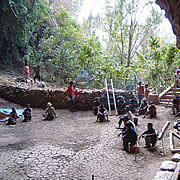|
News & Views item - October 2005 |
New
Discoveries on Flores Support
Homo floresiensis is
a Separate Species, but the Possibility for Further Research is in Doubt. (October
12, 2005)
|
|
|
Liang Bua cave © C. Turney, Univ. Wallongong |
In October 2005 a group
led by Michael Morwood, an archaeologist at the University of New England in
Armidale reported on the finding evidence for the
existence on the Indonesian island of Flores a species of hominid which it
believes had been subject to long-term isolation, with "subsequent endemic
dwarfing, of an ancestral H. erectus population. Importantly, H. floresiensis shows
that the genus Homo is morphologically more varied and flexible in its
adaptive responses than previously thought." While most
palaeoanthropologists
believe the data are convincing there has also been controversy with the
suggestion the data can be explained by the remains simply of a modern
human suffering from microcephaly.1,
2,
3.
One of the most vigorous opponents of the conclusions drawn by the UNE group is
politically well connected Teuku Jacob
of the Gajah Mada University in
Yogyakarta, Indonesia and described by Nature as a
national icon.
Nature
has made extensive material available online, much of it
accessible to
non subscribers. The
full 2004 article is also available, together with
supplementary material, online, but to subscribers only.
The UNE group now report in Nature on the bones of nine
additional individuals belonging to the species Homo floresiensis
at Liang Bua cave, where the first set of
crucial specimens were found in 2003.
The new H. floresiensis specimens range from 12,000 to at least 74,000
years old according to the report that will be published in the October 13 issue
of Nature.. The team also found stone tools, charred pebbles, and extinct
animals, including a dwarf elephant called Stegodon in the
hominid-bearing layers.
"This destroys the argument that the first skeleton was an aberrant individual,"
paleoanthropologist Russell Ciochon of the University of Iowa in Iowa City told
ScienceNow, but Anthropologist Robert D. Martin of the Field Museum in
Chicago, Illinois, remains on the fence saying, "I'm not 100% convinced it's
microcephaly, but I am convinced that that brain size doesn't go with those
tools."
But the major issue appears to be that it is doubtful that the UNE team and its
Indonesian colleagues will be able to continue their investigations of the
Liang Bua cave.
"My guess is that we will not work at Liang
Bua again, this year or any other year," Morwood.
The contention is that Indonesian government
officials will not issue exploration permits that might prove Teuku Jacob wrong
and Nature reports , "Neither Jacob nor the officials involved could be
reached for comment."
According to Nature "the new bones
also turned up features that are not found in modern humans. In particular, both
of the jaws unearthed lack a chin structure; chins are a distinguishing feature
of H. sapiens."
Morwood also told Nature that during
explorations this summer at other sites on Flores and neighbouring islands, the
team had found promising hints about the origin of H. floresiensis, but
no new hominid bones. Work in the Soa Basin, for example, suggests that hominids
were present on Flores significantly earlier than 840,000 years ago, the
earliest date previously reported by the group.
"That's what you might expect in the context of some of the very primitive
traits of H. floresiensis. Historically the emphasis for early hominid
studies has been Java. This may change."
Professor Peter Brown of UNE and a ranking member of the research team has
told the ABC that the recent work "supports that small-bodied, small-brained
bipedal apes came out of Africa much earlier than previously thought," and
causes them to question whether H. floresiensis arose from more recent
human relatives Homo erectus, as once proposed. Professor Brown added,
"The only creature which ever had these [H. floresiensis] body
proportions apart from the Liang Bua material was the African australopithecine
Lucy skeleton, nothing else."
"The evidence we
have from... 260 bones is pointing to something other than Homo erectus
or modern humans," and he now believes that the data are pointing towards an
australopithicine because the relationship between the brain size and body size
is "exactly" the same as that of chimpanzees and australopithicines." All this has made
Professor Brown and the team seriously question their original idea that the
hobbits evolved from Homo erectus that dwarfed on their island home. "To
me the Homo erectus dwarfing is looking less likely, particularly because
of the brain size, body size relationship. It's not what you'd expect to get,"
Professor Brown said, and he now believes H. floresiensis is descended
from an as yet unknown small-bodied and small-brained ancestor closely related
to an australopithicine.
Might this now be a time when Australia's Prime Minister, John Howard, could
intercede constructively with Indonesian President Susilo Bambang Yudhoyono to
resolve the matter in the interests of furthering scientific inquiry?
But Nature reports, "Early this
year, archaeologist Tony Djubiantono, director of the Indonesian Centre for
Archaeology in Jakarta, told Nature that digging in Liang Bua would
proceed in the summer. But he never issued the permits. Djubiantono, a co-author
on today's paper, could not be reached for comment. But sources say he is
reluctant to challenge Jacob and his allies in the upper echelons of the
Indonesian government.
